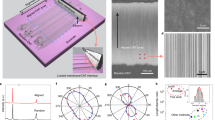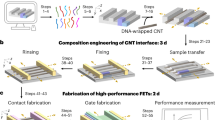Abstract
The controlled assembly of nanowires is a key challenge in the development of a range of bottom-up devices1,2. Recent advances2,3,4,5,6,7,8,9,10,11,12,13,14,15,16,17,18,19 in the post-growth assembly of nanowires and carbon nanotubes have led to alignment ratios of 80–95% for a misalignment angle of ±5° (refs 5, 12, 13, 14) and allowed various multiwire devices to be fabricated6,10,11,12,13,19. However, these methods still create a significant number of crossing defects, which restricts the development of device arrays and circuits based on single nanowires/nanotubes. Here, we show that a nanocombing assembly technique, in which nanowires are anchored to defined areas of a surface and then drawn out over chemically distinct regions of the surface, can yield arrays with greater than 98.5% of the nanowires aligned to within ±1° of the combing direction. The arrays have a crossing defect density of ∼0.04 nanowires per µm and efficient end registration at the anchoring/combing interface. With this technique, arrays of single-nanowire devices are tiled over chips and shown to have reproducible electronic properties. We also show that nanocombing can be used for laterally deterministic assembly, to align ultralong (millimetre-scale) nanowires to within ±1° and to assemble suspended and crossed nanowire arrays.
This is a preview of subscription content, access via your institution
Access options
Subscribe to this journal
Receive 12 print issues and online access
$259.00 per year
only $21.58 per issue
Buy this article
- Purchase on Springer Link
- Instant access to full article PDF
Prices may be subject to local taxes which are calculated during checkout




Similar content being viewed by others
References
Lu, W. & Lieber, C. M. Nanoelectronics from the bottom up. Nature Mater. 6, 841–850 (2007).
Wang, M. C. P. & Gates, B. D. Directed assembly of nanowires. Mater. Today 12, 34–43 (May, 2009).
Smith, P. A. et al. Electric-field assisted assembly and alignment of metallic nanowires. Appl. Phys. Lett. 77, 1399–1401 (2000).
Duan, X., Huang, Y., Cui, Y., Wang, J. & Lieber, C. M. Indium phosphide nanowires as building blocks for nanoscale electronic and optoelectronic devices. Nature 409, 66–69 (2001).
Huang, Y., Duan, X., Wei, Q. & Lieber, C. M. Directed assembly of one-dimensional nanostructures into functional networks. Science 291, 630–633 (2001).
Duan, X. et al. High-performance thin-film transistors using semiconductor nanowires and nanoribbons. Nature 425, 274–278 (2003).
Hangarter, C. M. & Myung, N. V. Magnetic alignment of nanowires. Chem. Mater. 17, 1320–1324 (2005).
Tao, A. et al. Langmuir–Blodgett silver nanowire monolayers for molecular sensing using surface-enhanced Raman spectroscopy. Nano Lett. 3, 1229–1233 (2003).
Whang, D., Jin, S., Wu, Y. & Lieber, C. M. Large-scale hierarchical organization of nanowire arrays for integrated nanosystems. Nano Lett. 3, 1255–1259 (2003).
Jin, S. et al. Scalable interconnection and integration of nanowire devices without registration. Nano Lett. 4, 915–919 (2004).
Javey, A., Nam, S., Friedman, R. S., Yan, H. & Lieber, C. M. Layer-by-layer assembly of nanowires for three-dimensional, multifunctional electronics. Nano Lett. 7, 773–777 (2007).
Yerushalmi, R., Jacobson, Z. A., Ho, J. C., Fan, Z. & Javey, A. Large scale, highly ordered assembly of nanowire parallel arrays by differential roll printing. Appl. Phys. Lett. 91, 203104 (2007).
Fan, Z. et al. Wafer-scale assembly of highly ordered semiconductor nanowire arrays by contact printing. Nano Lett. 8, 20–25 (2008).
Yu, G., Cao, A. & Lieber, C. M. Large-area blown bubble films of aligned nanowires and carbon nanotubes. Nature Nanotech. 2, 372–377 (2007).
Li, M. et al. Bottom-up assembly of large-area nanowire resonator arrays. Nature Nanotech. 3, 88–92 (2008).
Fan, Z. et al. Toward the development of printable nanowire electronics and sensors. Adv. Mater. 21, 3730–3743 (2009).
Freer, E. M., Grachev, O., Duan, X., Martin, S. & Stumbo, D. P. High-yield self-limiting single-nanowire assembly with dielectrophoresis. Nature Nanotech. 5, 525–530 (2010).
Nam, S-W. Assembly and Integration of Nanowires and Grapheme for Nanoelectronics and Nanobiotechnology Ch. 2 (Harvard Univ. Press, 2011).
Ishikawa, F. N. et al. Transparent electronics based on transfer printed aligned carbon nanotubes on rigid and flexible substrates. ACS Nano 3, 73–79 (2009).
Takei, K. et al. Nanowire active-matrix circuitry for low-voltage macroscale artificial skin. Nature Mater. 9, 821–826 (2010).
Cao, Q. et al. Medium-scale carbon nanotube thin-film integrated circuits on flexible plastic substrates. Nature 454, 495–500 (2008).
Michalet, X. et al. Dynamic molecular combing: stretching the whole human genome for high-resolution studies. Science 277, 1518–1523 (1997).
Cui, Y., Zhong, Z., Wang, D., Wang, W. U. & Lieber, C. M. High performance silicon nanowire field effect transistors. Nano Lett. 3, 149–152 (2003).
Cai, L., Bahr, J. L., Yao, Y. & Tour, J. M. Ozonation of single-walled carbon nanotubes and their assemblies on rigid self-assembled monolayers. Chem. Mater. 14, 4235–4241 (2002).
Yan, H. et al. Programmable nanowire circuits for nanoprocessors. Nature 470, 240–244 (2011).
Xiang, J., Lu, W., Hu, Y., Yan, H. & Lieber, C. M. Ge/Si nanowire heterostructures as high-performance field-effect transistors. Nature 441, 489–493 (2006).
Park, W. I., Zheng, G., Jiang, X., Tian, B. & Lieber, C. M. Controlled synthesis of millimeter-long silicon nanowires with uniform electronic properties. Nano Lett. 8, 3004–3009 (2008).
Yaman, M. et al. Arrays of indefinitely long uniform nanowires and nanotubes. Nature Mater. 10, 494–501 (2011).
Tsivion, D., Schvartzman, M., Popovitz-Biro, R., von Huth, P. & Joselevich, E. Guided growth of millimeter-long horizontal nanowires with controlled orientations. Science 333, 1003–1007 (2011).
Kang, S. J. et al. High-performance electronics using dense, perfectly aligned arrays of single-walled carbon nanotubes. Nature Nanotech. 2, 230–236 (2007).
Husain, A. et al. Nanowire-based very-high-frequency electromechanical resonator. Appl. Phys. Lett. 83, 1240–1242 (2003).
Sazonova, V. et al. A tunable carbon nanotube electromechanical oscillator. Nature 431, 284–287 (2004).
Feng, X. L., He, R., Yang, P. & Roukes, M. L. Very high frequency silicon nanowire electromechanical resonators. Nano Lett. 7, 1953–1959 (2007).
Acknowledgements
The authors thank J. Ellenbogen, S. Das and J. Klemic for helpful discussion, and J. Huang for modification of the nanocombing assembly tool. C.M.L. acknowledges support of this work from a contract from the MITRE Corporation (awards 92007 and 92009) and a National Security Science and Engineering Faculty Fellow award (N00244-09-1-0078).
Author information
Authors and Affiliations
Contributions
J.Y. and C.M.L. designed the experiments. J.Y. performed the experiments and data analysis. H.Y. helped in nanowire synthesis and device fabrication. J.Y. and C.M.L. co-wrote the manuscript. All authors discussed the results and commented on the manuscript.
Corresponding author
Ethics declarations
Competing interests
The authors declare no competing financial interests.
Supplementary information
Supplementary information
Supplementary information (PDF 1488 kb)
Rights and permissions
About this article
Cite this article
Yao, J., Yan, H. & Lieber, C. A nanoscale combing technique for the large-scale assembly of highly aligned nanowires. Nature Nanotech 8, 329–335 (2013). https://doi.org/10.1038/nnano.2013.55
Received:
Accepted:
Published:
Issue Date:
DOI: https://doi.org/10.1038/nnano.2013.55
This article is cited by
-
Van der Waals nanomesh electronics on arbitrary surfaces
Nature Communications (2023)
-
Cryogenic multiplexing using selective area grown nanowires
Nature Communications (2023)
-
Nanograin network memory with reconfigurable percolation paths for synaptic interactions
Light: Science & Applications (2023)
-
Influence of Micro- and Nanoporous Silicon Layers with Different Depth and Pore Morphology on Contact Angle, Adhesion and Viability of Cells
Silicon (2023)
-
Toward monolithic growth integration of nanowire electronics in 3D architecture: a review
Science China Information Sciences (2023)



